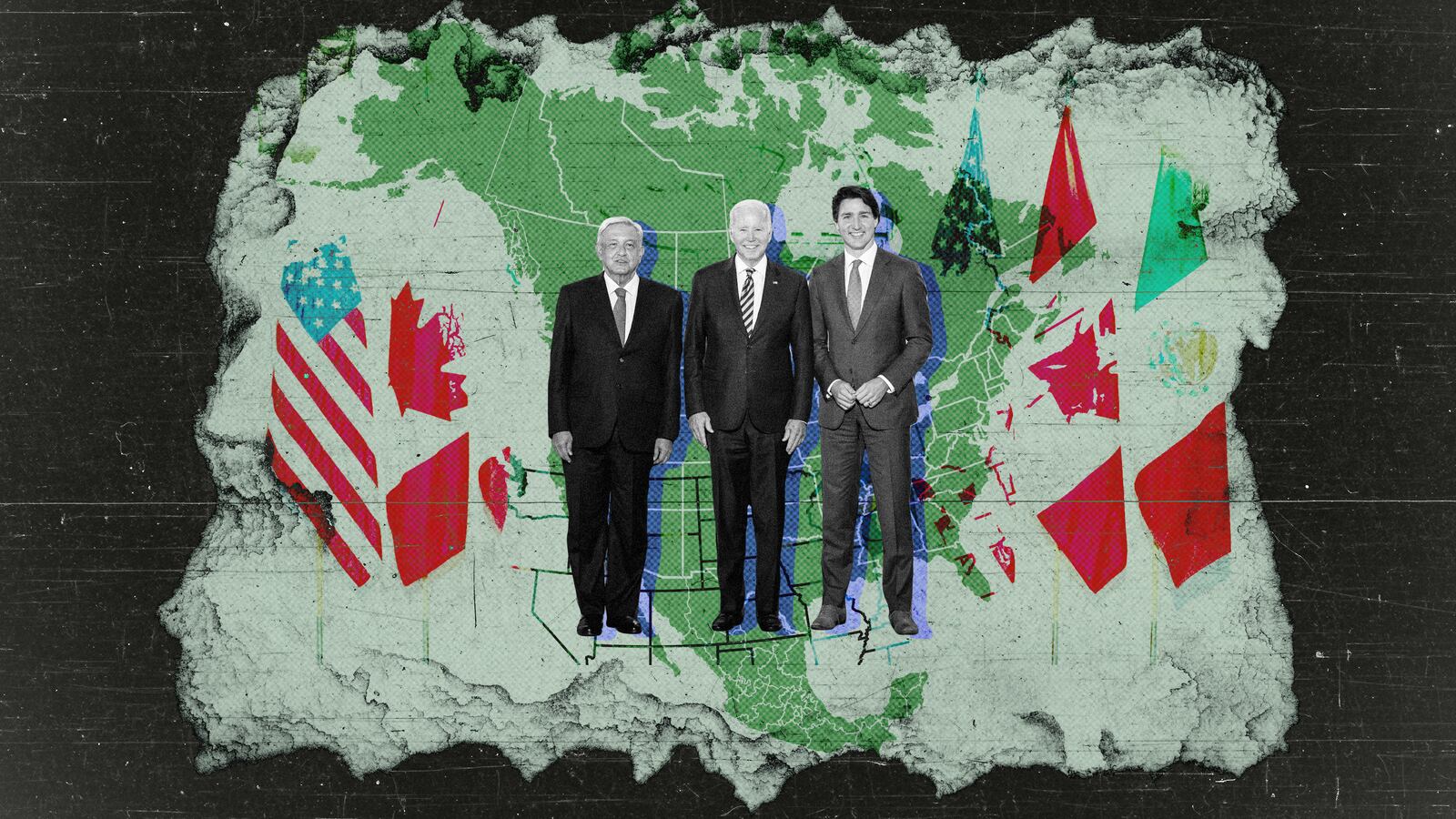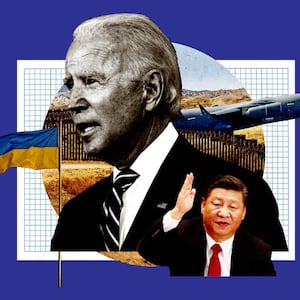The 10th North American Leaders Summit (NALS) that will unfold Monday and Tuesday in Mexico City is likely the most consequential trilateral summit amongst the three neighbors and partners since former President George W. Bush launched the annual regional summitry mechanism in 2005 in the aftermath of the terrorist attacks of 2001.
It didn’t take a Bismarck to figure out that common prosperity and common security were holistically intertwined between Canada, Mexico, and the United States. It’s also unsurprising that any threat—or a perceived threat—to U.S. national security emanating either from the Canadian or Mexican borders would bring down the edifice (and the promise) of integrated trade and cross-border trade facilitation that has existed since the North American Free Trade Agreement (NAFTA) in 1994.
While in theory this premise should have provided greater strategic traction, clarity, and attention within the three nations, the NALS has consistently underwhelmed and underdelivered. Then-Secretary of State Condoleezza Rice even likened relations amongst the three North American nations to a co-op board.
True, some important policy drivers have arisen as a result of the NALS—such as the North American Plan for Avian and Pandemic Influenza (NAPAPI) launched after the 2007 summit, which led to a comprehensive document designed to prepare for a pandemic in North America. In 2009, faced with the H1-N1 pandemic, the NAPAPI allowed Mexico, the U.S., and Canada to effectively confront and contain that public health crisis. But that’s the exception to the rule.
Unfortunately, most of the previous summits have been more symbolic than substantive. Despite what’s at stake geopolitically today in the world and for U.S. foreign policy, this summit will most likely be symbolic, too.
After a troubling four-year hiatus as a result of President Donald Trump’s diplomatic vandalism, it is undoubtedly encouraging to see the Biden administration continue its rebuilding and relaunching of the bilateral and trilateral architecture that underpins relations in North America. Nonetheless, a lack of strategic vision and appetite continue to bedevil ties amongst the three nations—and Washington, Ottawa, and Mexico City are, to one extent or another, all to blame.

President Joe Biden, Canadian Prime Minister Justin Trudeau and Mexican President Andres Manuel Lopez Obrador participate in the first North American Leaders’ Summit (NALS) since 2016 in the East Room at the White House Nov. 18, 2021 in Washington, DC.
Alex Wong/Getty ImagesMoreover, today there’s no doubt that there’s a mismatch between opportunity and reality in North America.
The opportunity lies in the fact that the U.S. is in the midst of the most important recalibration of its foreign policy and national security interests since the end of the Cold War, as it reviews and seeks to recast its strategic stance vis-à-vis China. If that recalibration—and the strategic paradigm that results from it—is to prove successful, particularly in the trade and economic domains, Canada and Mexico need to become an integral part of that vision.
There are four areas of common North American engagement where this is particularly relevant.
First, as the COVID pandemic revealed, we need to protect our integrated and essential supply chains and joint production platforms, one of the most salient byproducts of three decades of regional trade integration. Regional integration has made North America an economic powerhouse; it accounts for a third of global GDP and its combined GDP has more than doubled over the past decade. The U.S. traded more than $3 million per minute in goods with its neighbors from January through October 2022, while Mexico and Canada were the top two U.S. trade partners in 2022, accounting for double the U.S.-China trade volume that year.
Roughly 79 percent of Canadian exports to the U.S. are incorporated into U.S. final goods and around 40 percent of the value of Mexican exports to the U.S. are made up of U.S. components. Moreover, with the passage of the Inflation Reduction Act and the CHIPS Act in the U.S.—creating tax incentives for electric vehicles, batteries, and other products manufactured in North America—working to take advantage of this potential for companies and investment in North America is a very big opportunity which should only buttress greater inflows of re-shoring and nearshoring into the region.

Prime Minister Justin Trudeau delivers a speech at Canada's first large-scale EV manufacturing plant in Ingersoll, Canada.
R.J. Johnston/Toronto Star via Getty ImagesSecond, as the region and its huge manufacturing footprint moves towards a digital economy and the North American auto parts and automotive juggernaut transitions towards electric vehicles—achieving a joint paradigm for regional energy security, resilience, sustainability, and independence will be paramount. It would also be a keystone in that economic, trade, and business recalibration to ensure North America’s greater global competitiveness.
Third, despite measures seeking to stem record levels of migration across the Americas, the massive North American labor demand is undeniable.
Canada’s economy lost an estimated $9.6 billion in 2021 due to a nationwide labor and skills shortage in the manufacturing sector. In the same year, in the U.S., more than 47 million workers quit their jobs during the Great Resignation, contributing to a gap of 11 million job openings—but only six million unemployed workers. Meanwhile, two in three Mexican employers reported difficulty finding talent in 2022.

A U.S. Border Patrol vehicle sits on a hillside as a freight train carries cargo containers in the El Paso Sector along the US-Mexico border between New Mexico and Chihuahua state on Dec. 9, 2021 in Sunland Park, New Mexico.
Patrick T. Fallon/AFP via Getty ImagesBuilding upon the Los Angeles Declaration on Migration which the three nations signed there during the Summit of the Americas—Canada, Mexico, and the U.S. should strive to find ways to create legal, orderly, transparent mechanisms to foster North American labor mobility. Human capital—and the retraining of skilled workers in our region—will be another key component of that successful recalibration of Washington’s ties with Beijing.
And finally, common domain awareness in North America—particularly when it comes to cybersecurity and the protection of both intellectual property and industrial data and national security infrastructure from Alaska to Chiapas—requires deeper and more consistent efforts to ensure common protocols, standards. It also requires helping to boost Mexico’s governmental and private sector capabilities in regards to preventing cyberattacks by extra regional state or non-state actors. This is an issue that was starkly delineated when the country’s defense ministry suffered a major hack that made millions of classified documents and emails public.
But herein comes the reality check. These enormous opportunities are not being met by the necessary diplomatic bandwidth.
Whether it’s Washington naturally preoccupied with and focused on Russian aggression in Eastern Europe, or Mexico City’s public policy mix and lack of appetite and vision, the fact remains that the opportunity to forge a more cohesive and forward-leaning North America may come to naught.
On energy, whereas the U.S. and Canada are aligned on the importance of climate change, mitigating emissions, a green economy, and renewable sources of energy, Mexico is heading backwards, in the opposite direction, pursuing fossil fuel policies and the boondoggle of building new refineries.
This, in part, explains why the U.S. and Canada requested consultations under the revamped trade agreement, the USMCA, in response to Mexico’s energy policy.
And Mexican President Andres Manuel Lopez Obrador continues to poke his finger in the eye of the U.S.—whether it’s regarding Julian Assange or stating that while “Biden is his partner, Putin is his friend,” or what he insists is Washington’s proclivity to intervene in the domestic affairs of hemispheric nations. Moreover, his pro-Russian neutrality (regarding its unjustified war of aggression and invasion of Ukraine), his defense of the Cuban, Venezuelan, and Nicaraguan regimes, and his boycott of the Summit of the Americas all mean that when it comes to seeking to a more coordinated and cooperative North American posture regarding regional or global affairs, the U.S. and Canada cannot count on their Mexican partner.
More importantly, the deterioration of Mexico’s democratic underpinnings, the erosion of checks and balances and the weakening of autonomous institutions—which will predictably not be on the agenda of the trilateral conversations, but are nonetheless an important backdrop to the summit—could, at the end of the day, be the most salient challenge to the cohesion, well-being and security of North America in the coming years.









